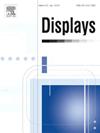Low-Power integrated driver circuits with multiple outputs based on Thin-Film transistors for mobile micro Light-Emitting diode displays
IF 3.7
2区 工程技术
Q1 COMPUTER SCIENCE, HARDWARE & ARCHITECTURE
引用次数: 0
Abstract
This article proposes low-power integrated driver circuits based on low-temperature polycrystalline silicon (LTPS) thin-film transistors (TFTs) for small and medium-sized mobile micro light-emitting diode (μLED) displays. Two integrated driver circuits can output four signals to operate the μLED pixel circuit: the integrated scan driver outputs two scan signals, and the integrated emission driver outputs an emission signal and a sweep signal. Moreover, driver circuits are designed to enable the always-on-display (AOD) mode, which consumes less power than the normal mode. Compared to the normal mode, the proposed circuits do not output unnecessary signals in the AOD mode, reducing power consumption by 38.0 and 29.6% in the integrated scan and emission circuits. In addition, compared to the gate driver circuits with a single output signal. The proposed integrated scan and emission driver circuits reduce power consumption by 16.6 (25.2) and 42.5 (51.3)% in the normal (AOD) mode, respectively, by sharing the control unit for multiple outputs. We also fabricated the proposed driver circuits and verified that the proposed circuits successfully output multiple signals for mobile μLED pixel circuits.
求助全文
约1分钟内获得全文
求助全文
来源期刊

Displays
工程技术-工程:电子与电气
CiteScore
4.60
自引率
25.60%
发文量
138
审稿时长
92 days
期刊介绍:
Displays is the international journal covering the research and development of display technology, its effective presentation and perception of information, and applications and systems including display-human interface.
Technical papers on practical developments in Displays technology provide an effective channel to promote greater understanding and cross-fertilization across the diverse disciplines of the Displays community. Original research papers solving ergonomics issues at the display-human interface advance effective presentation of information. Tutorial papers covering fundamentals intended for display technologies and human factor engineers new to the field will also occasionally featured.
 求助内容:
求助内容: 应助结果提醒方式:
应助结果提醒方式:


